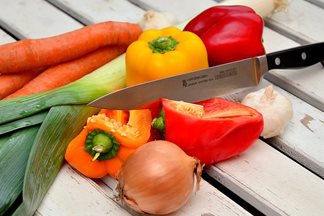
Summer is finally here with us and with the sun being as scorching hot as it is; our bodies are bound to exhibit some signs of fatigue and lack of energy along the way. Therefore, it is vital to ensure that we keep our bodies hydrated and nourished by taking lots of vegetables, fruits and water. In this article, we are going to explore six vegetable cuts that will make your vegetables look uniform with neat edges and give them a mouth watery appealing look.
The chiffonade cut is a cut specifically intended for leafy vegetables and herbs that is used to prepare herbs and vegetables for seasoning, salads and light garnishes. It often involves cutting the vegetable leaves and herbs into thin slices of about 1 mm wide.
A brunoise is a fine dice cut measuring 4 mm x 4 mm x 4 mm or 1/8 x 1/8 x 1/8 inches. You will often find brunoise cuts being used in sauces because they require small sized pieces to release more flavor quickly. However, you can also sprinkle the tiny cubes to any dish to add some pomp and color to it.
The julienne cut is often used for firm vegetables such as carrots, celery, and cucumbers. The thin strips or sticks that are ultimately achieved from this cut are then used as ingredients and garnishes for a number of dishes. A standard julienne is supposed to be 4 mm x 4 mm x 5 cm or 1/8 x 1/8 x 2 inches.
The jardinière is short and thick baton cuts from one's choice of vegetables. Jardinière sizes range from 2 cm x 4 mm x 4 mm or much larger sizes of 4 cm x 10 mm x 10 mm. These vegetable batons are usually used to add a little bit of texture to soup or a stir fry dish or better yet prepared as a vegetable side dish.
This is a wide thin cut that is often adopted when cooks want to get a chunkier texture from small vegetable portions. You will mostly find it being used in Mirepoix, sautéed vegetables, sauces, soups, and stocks.
These are large, thick cubes with sizes measuring from 5 mm to 10 mm. They are frequently used in soups, sauces, and meals that require chunkier vegetable content.
With a good wood butcher block board, it will be much easier for you to make this basic cooking cuts and you will be able to enjoy neatly cut out vegetables.